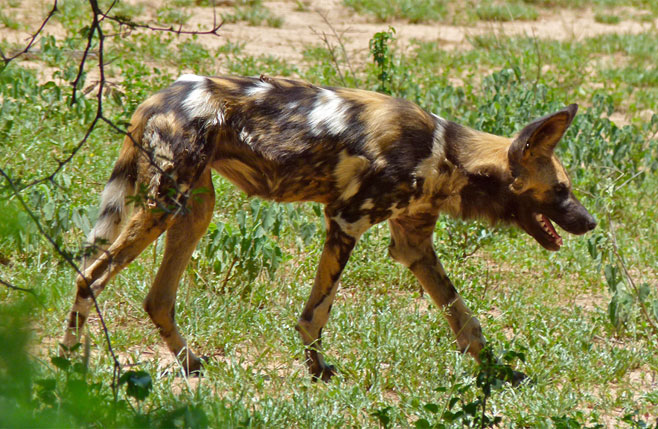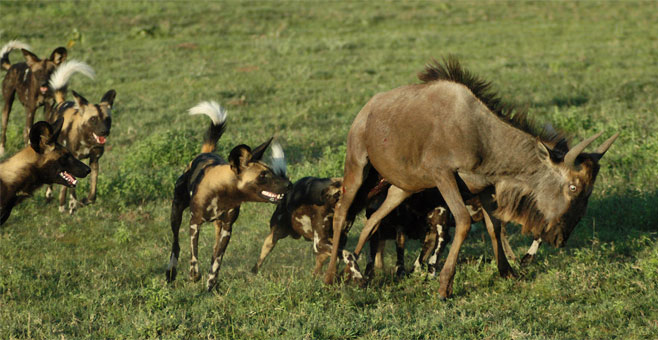|
Lycaon pictus (African wild dog, Painted
hunting dog)
Cape hunting dog, wild dog, painted hunting dog [English]; wildehond [Afrikaans]; Hyanenhund, Afrikanischer Wildhund [German]; cynhyenè
[French]; mbwa mwitu [Swahili]; iganyana, iketsi leKapa [isiNdebele]; ixhwili [isiXhosa]; inkentshane, inkontshane [isiZulu]; lehlaerwa, letaya [Sepedi]; lekanyana,
lekênyane, leteane, letlhalerwa, letlharelwa, lekayana [Setswana]; mhumhi, mhumi
[Shona]; budzatja, budzatje, inkentjane [siSwati]; hlolwa [Xitsonga]; dalerwa [Tshivenda]; liakanyani [Lozi]; umenzi [Yei]; !Gaub [Nama] [Damara]
Life
>
Eukaryotes >
Opisthokonta >
Metazoa (animals) > Bilateria > Deuterostomia >
Chordata > Craniata > Vertebrata (vertebrates) >
Gnathostomata (jawed vertebrates) > Teleostomi (teleost
fish) > Osteichthyes (bony fish) > Class:
Sarcopterygii (lobe-finned fish) > Stegocephalia
(terrestrial vertebrates) > Reptiliomorpha > Amniota >
Synapsida (mammal-like reptiles) > Therapsida > Theriodontia
> Cynodontia > Mammalia (mammals)
> Placentalia (placental mammals) > Laurasiatheria
> Ferungulata > Ferae > Carnivora > Family:
Canidae (foxes, dogs and jackals)
 |
|
Lycaon pictus (African wild dog), Kruger
National Park, South Africa. [photo Arno Meintjes
©] |
 |
|
Lycaon pictus (African wild dog) near
N'watimhiri Causeway, Kruger National Park, South Africa. [photo
Bernard Dupont ©] |
Once widespread in subsaharan Africa, the
distribution of the African wild dog is now limited to a few large
game reserves and wild areas, and is classified as endangered by the
IUCN. It lives and hunts in packs with a dominant male and female in
each pack. The pack assists the alpha female in rearing and
protecting her litters of puppies. Packs require large home ranges
and hunt down prey such as antelope over long distances, eventually
dragging the exhausted prey to the ground and tearing it open.
Identification
It is easily identified by its irregularly
heavily blotched coat, in patches of white black, and yellow-brown.
Its scientific name is well suited as Lycaon pictus means
“the painted or ornamental wolf”. Similar in size to the domestic
German Shepherd dog, the muscular body is slender with long legs. It
has large, dark, rounded ears, that indicate how important sound is
in communication between the pack members and also probably aid
cooling. The short powerful muzzle is black and a black line
continues between the eyes to the ears. The tail has a white plume
of long hair. The wild dog is the least typical of the canids, its
muzzle is relatively short, the last molar is poorly developed and
it has lost the fifth digit – or dew claw- from the front feet. The
dentition is well-adapted for holding and shearing meat, but not for
chewing and grinding.
Size
Total Body Length: 105-150 cm; height at
shoulder 65-80 cm; weight range 20-30 kg.
Dental Formula
I C C P P M M =
42 =
42
Distribution and habitat
Previously occurred widely in Africa from the
Sahara to South Africa, outside the equatorial forests. In southern
Africa it occurs permanently in the Kruger National Park, other
larger reserves and uninhabited areas. It has been reintroduced to
parks in KwaZulu Natal. Prefers open grassland, avoids dense
woodland, forest and extensive areas of tall grass. Woodland scrub
is a preferred habitat as it offers sufficient shelter and
concealment but is open enough for pursuit while hunting.
General behaviour
The wild dog lives and hunts in packs, with
usually 10 -15 animals in a pack. Each pack has a dominant (alpha)
male and female, their recent offspring, and non-breeding adults who
are siblings or offspring of a member of the dominant pair.
Dominance is tested continually within the pack members, but this is
usually by ritual rather than direct aggression. During the mating
season the males will fight vigorously for dominance and the right
to breed but the dominant female will remain the matriarch. Wild
dogs do not establish territories and have a very large home range -
for instance the average home range of packs in the Serengeti is
about 1500 km2 a although home ranges of adjacent packs
do overlap. If the habitat is arid and below optimal then the ranges
will be larger.
Food
Wild dogs are primarily diurnal, and will
usually hunt early in the morning and evening avoiding the heat of
the day. They are also known to hunt at night when there is good
moonlight. These dogs are adapted to capture medium sized antelope
such as Impala
and Springbok.
The primary method of hunting is to chase the prey until it tires
and can then be caught and pulled down. In pursuit over open ground
the dogs can reach speeds of 50-60 km/h. Smaller prey is killed
immediately but larger animals are kept running while the dogs
continue to bite and tear at it, eventually it will tire and is then
held, usually at the upper lip, tail and flank while other members
of the pack disembowel it. The prey then dies of shock or loss of
blood. While this may appear a rather grizzly method of hunting, it
enables the dogs to secure prey large enough to feed the pack, and
they only kill when they need food. The hunt is carefully
strategized and highly cooperative with the dogs remaining in
communication throughout the pursuit. Chases may cover several
kilometres until the prey tires, there are always additional pack
members following or running parallel to take up the chase or to
assist. Some packs in different areas specialize in hunting
particular species - for instance, in northern Botswana its
Warthog and
Ostrich.
Prey includes a wide range of mammals, from
Steenbok to
African buffalo,
also includes rodents,
hares and
birds.
 |
|
 |
|
African wild dog pack successfully taking down a
Blue wildebeest,
Tanzania. [photos Chris van de Berge ©] |
Reproduction
After a gestation period of 72 days the female
gives birth to a litter of 6 – 14 puppies in a burrow. Litters are
usually born during the dry winter months. Initially the puppies
suckle milk from their mother but after a few weeks they start to
eat meat. This meat is obtained from the pack members who gorge
themselves at a kill and then regurgitate the partially digested
meat for the pups (see image below), as well as the mother and older members of the
pack that have remained behind to guard the litter. The pups remain
in the immediate vicinity of the den for the first 3 months. As they
grow older they will accompany the pack on hunts although they will
not participate until they are old enough. Adults in the pack will
go back and find the young stragglers and escort them to the kill to
feed. Juveniles are given priority to feed at a kill while the
obviously hungry adults wait. Despite the nurturing that the puppies
receive from the pack, in the end generally only a few of them will
survive.
|
 |
|
African wild dog pups eating some food
regurgitated by the alpha female, Tanzania. [photo Chris van de Berge ©] |
Life span
4-8 years
Conservation
The African wild dog is probably the rarest
carnivore in Africa. Only an estimated 5 500 of them remain, in a
few substantial but isolated populations remaining in eastern and
southern Africa. This total also includes the smaller populations in
sub-Saharan Africa. Exclusively carnivorous and as active hunters
requiring an extensive habitat the wild dog is constantly in
competition with humans, resulting in conflict with game and stock
farmers. Other factors that contribute to the decline of populations
include road kills, snaring, habitat fragmentation, loss of prey and
a vulnerability to a large number of infectious diseases including
rabies, parvo-virus enteritis,
anthrax and canine distemper. The future of this species is
dependent on conservation of areas with its particular requirements
in mind, the prevention of direct persecution, and captive breeding
programmes with subsequent reintroductions. Currently the species is
classified as endangered.
Links
Text by Denise Hamerton |
